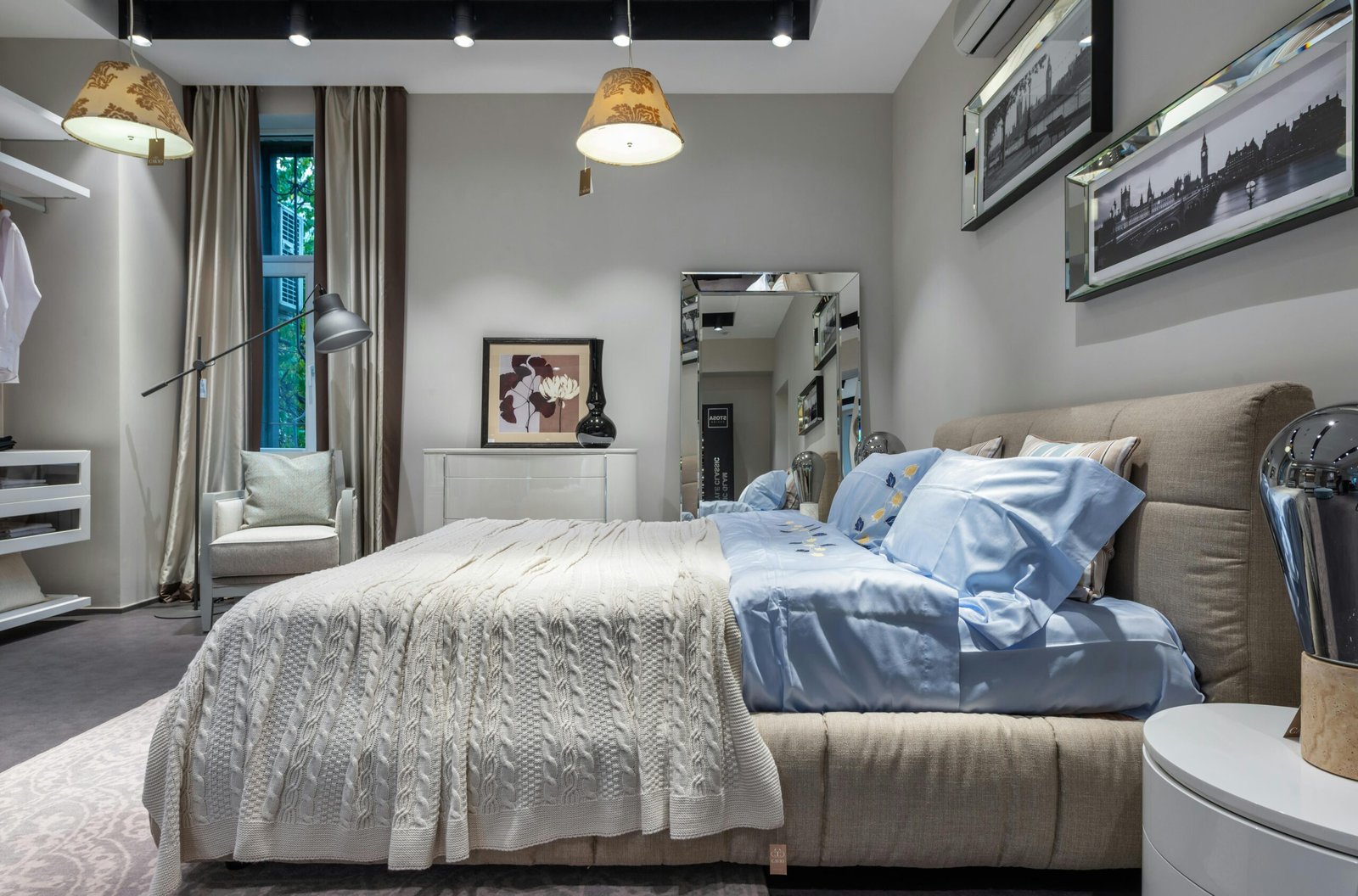In today’s fast-paced world, finding peace and tranquility can seem like a challenge. Our homes, ideally, should be a sanctuary from the hustle and bustle, a place where we can relax, recharge, and reconnect with ourselves. Creating a Zen space in your home is a simple yet effective way to bring calm, focus, and balance into your life. Inspired by Japanese design principles, a Zen space is all about simplicity, natural elements, and fostering an environment of peace.
Whether you’re looking to build a meditation nook, a relaxing reading corner, or a serene retreat for your mind and body, here’s how you can create a Zen space in your home that helps you unwind and rejuvenate.
1. Choose a Quiet Space
The first step to creating a Zen space is selecting a location that is quiet, private, and free from distractions. Ideally, this should be a spot in your home that’s away from the noise and activity of daily life—think a corner of a room, a cozy nook near a window, or even a secluded spot in your backyard if possible.
Things to consider when choosing your space:
- Natural light: A space with good natural light can make a significant difference in how calming the environment feels. If possible, choose a room with windows to let in the sunlight.
- Minimal distractions: Avoid areas that are filled with noise, high traffic, or clutter. The goal is to have a place where you can focus without interruptions.
- Comfort: You’ll want your Zen space to be comfortable, so avoid choosing a spot that’s too hard, cold, or uncomfortable to sit or relax in for extended periods.
2. Declutter for a Clear Mind
A Zen space is all about simplicity and minimalism. Clutter can create mental chaos and make it difficult to relax. Start by clearing out any unnecessary items that don’t serve a purpose in the space. The less visual clutter, the more peaceful the environment will feel.
Tips for decluttering:
- Remove unnecessary furniture: Stick to just the essentials. A comfortable chair, a cushion, a small table, or a shelf may be all you need.
- Keep surfaces clean: Only display items that promote relaxation or have personal significance, such as candles, plants, or meaningful art.
- Use storage: If there are things you need to store in the space, consider hidden storage options like baskets, drawers, or storage ottomans to maintain a clean and tidy look.
3. Incorporate Natural Elements
Zen spaces often focus on the natural world, bringing the outdoors in to promote a sense of calm and connectedness. The use of natural materials like wood, stone, plants, and water can help create a soothing atmosphere.
Ways to incorporate natural elements:
- Indoor plants: Plants bring life to your Zen space and improve air quality. Opt for low-maintenance plants like bamboo, succulents, or peace lilies. These plants not only look beautiful but also contribute to the peaceful ambiance.
- Wooden furniture or decor: Wooden elements add warmth and grounding energy to a space. Look for wooden shelves, tables, or even bamboo mats for a natural feel.
- Stone accents: Small stones, crystals, or a Zen garden with rocks can add a sense of stability and grounding.
- Water features: If you have the space, a small tabletop fountain or a water feature can enhance the calming atmosphere with the sound of running water.
4. Use Soft, Neutral Colors
Color plays a significant role in creating a peaceful environment. In a Zen space, you’ll want to choose soft, neutral colors that promote relaxation and tranquility. Think earthy tones, light grays, whites, and soft browns—these colors create a sense of spaciousness and harmony.
Best color choices for a Zen space:
- Whites and off-whites: These shades create an airy and peaceful atmosphere. They make small spaces feel larger and can act as a calming backdrop.
- Soft greens and blues: These colors mimic nature and are known for their calming effects.
- Earthy browns and beiges: These natural tones evoke a sense of grounding and balance.
Avoid loud, bright colors like neon or bold reds that might evoke feelings of anxiety or overstimulation. Stick with subtle tones that promote calm and focus.
5. Create a Comfortable Seating Area
Your Zen space should be somewhere you can comfortably sit, meditate, read, or reflect. Choose seating that feels inviting and aligns with the peaceful vibe of the space. Whether it’s a cozy chair, floor cushions, or a soft rug, the seating should invite relaxation.
Seating options for a Zen space:
- Floor cushions or meditation mats: Perfect for sitting in a cross-legged position to meditate or simply enjoy quiet time.
- Comfortable chairs or benches: A simple, minimalist chair or bench with a soft cushion can be ideal for moments of contemplation or reading.
- Tatami mats or low seating: In true Zen style, you might opt for low seating arrangements like tatami mats, which are traditional Japanese mats made of straw, offering both comfort and simplicity.
Remember, the seating should encourage relaxation and not create any tension in your body. Select furniture that fits your body comfortably and promotes good posture.
6. Add Lighting to Enhance the Mood
Lighting is essential in setting the tone of your Zen space. Soft, warm lighting promotes a peaceful atmosphere, while harsh, bright lights can create stress. Opt for ambient lighting that soothes the senses and helps you unwind.
Lighting options for your Zen space:
- Dim lighting: Use floor lamps, table lamps, or candles with soft, warm bulbs. Avoid bright overhead lights that can feel jarring.
- Fairy lights or string lights: These can add a subtle glow to the room and create a magical, calming effect.
- Candles or incense: Scented candles or incense not only add to the ambiance but also introduce pleasant aromas that enhance relaxation. Lavender, sandalwood, or jasmine are excellent calming scents.
Consider placing your lighting sources strategically, allowing them to cast soft shadows and create a tranquil environment.
7. Introduce Calm and Soothing Sounds
Sound plays a crucial role in creating a Zen atmosphere. Silence is golden, but introducing gentle background noise can enhance your space. Natural sounds, like water flowing or birds chirping, can help create a soothing ambiance.
How to add calming sounds:
- A small water fountain: The gentle sound of running water can be incredibly calming and is often used in Zen gardens and spaces.
- Nature sound playlists: If you’re not near nature, consider playing a playlist of nature sounds (rainfall, ocean waves, forest sounds) to mimic the calming effects of the outdoors.
- Binaural beats or soft instrumental music: Some people find that music without lyrics—like classical music, Tibetan bowls, or binaural beats—helps induce relaxation and focus.
Whatever you choose, make sure the sound is gentle and non-intrusive, allowing you to remain in a state of calm.
8. Personalize Your Space with Meaningful Items
While simplicity is key in a Zen space, adding a few personal items that bring you peace can enhance the environment. These could be items that inspire you, remind you of loved ones, or contribute to your sense of well-being.
Ideas for personalizing your Zen space:
- Art and symbols: Consider adding minimalist art or symbols that have special meaning for you, like a mandala, a peaceful landscape, or abstract pieces in soft tones.
- Inspiring quotes: A simple, handwritten note or a framed quote that speaks to your values can offer daily motivation.
- Meditation tools: If you meditate, keep your essential tools close by, such as a singing bowl, crystals, or a mala bracelet.
The key is to keep your items meaningful and not over-clutter the space. Personal touches should enhance the peace of the room, not detract from it.
9. Keep It Smelling Fresh and Clean
The air quality and scents in your Zen space play a huge role in creating a calming environment. Keeping your space clean and free from any musty or unpleasant smells is essential for maintaining a Zen-like atmosphere.
How to freshen up your space:
- Essential oils: Use a diffuser to fill your Zen space with calming essential oils like lavender, eucalyptus, or chamomile.
- Aromatherapy candles: Choose candles with natural scents that align with relaxation.
- Regular cleaning: A clean space is a peaceful space. Regularly dust, vacuum, and declutter your Zen area to keep the environment feeling fresh.
10. Make Time for Regular Use
To fully experience the benefits of your Zen space, you need to make time to actually use it regularly. The more you incorporate this peaceful retreat into your daily routine, the more it will become a sanctuary for your mind and soul.
How to use your Zen space effectively:
- Morning meditation: Start your day with a moment of calm, meditating, breathing deeply, or stretching in your Zen space.
- Evening wind-down: Use your Zen space as a way to unwind after a long day, perhaps reading, journaling, or simply sitting in silence to decompress.
- Mindful breaks: If you work from home, use your Zen space for short, mindful breaks to recharge your energy.
The key is consistency—making your Zen space a regular part of your daily routine will allow you to reap its benefits of calm, focus, and peace.
Conclusion: Creating Your Zen Sanctuary
A Zen space is a perfect escape from the chaos of modern life. By carefully selecting the right location, decluttering, incorporating natural elements, and focusing on simplicity, you can create an environment that nurtures relaxation, mindfulness, and clarity. Remember, the goal of a Zen space is to cultivate peace—not
perfection. It’s all about creating a place where you can find balance and retreat from the outside world, even if only for a few minutes a day.
Take your time creating your Zen space, and don’t be afraid to make it personal. Your space should reflect what makes you feel calm, centered, and at peace.
FAQs
1. Can I create a Zen space if I live in a small apartment?
Absolutely! Zen spaces can be created in even the smallest of spaces. Focus on one corner or nook where you can sit, relax, and declutter. You don’t need a large area—just a peaceful spot to call your own.
2. How often should I use my Zen space?
The more frequently you use it, the more beneficial it will be. Even a few minutes of quiet time each day can help clear your mind and reduce stress.
3. Do I need to meditate in my Zen space?
While meditation is a common practice in a Zen space, it’s not a requirement. You can use your space for anything that helps you relax—reading, journaling, stretching, or simply sitting in silence.
4. How can I make my Zen space feel more luxurious?
Add elements like soft textures (plush pillows, throws), high-quality candles, or luxurious plants like orchids. These details can elevate the space while still maintaining simplicity.
5. Can I use my Zen space for work or productivity?
While it’s ideal for relaxation, you can also use your Zen space for focused work, as long as it doesn’t interfere with the peaceful atmosphere. Keep the tasks light and free from distractions.




